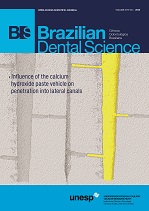Multidisciplinary treatment: association among orthodontics, implantodontia and prosthetics. Case report
DOI:
https://doi.org/10.14295/bds.2018.v21i3.1552Abstract
Deficiencies in the alveolar ridge, dental migration and malocclusion are conditions that may hamper restorative treatment and thus must be resolved by taking a multidisciplinary approach. This clinical case report is associated with orthodontics, implantology and prostheses for rehabilitation. A 34-year-old male patient presented himself in a private practice complaining of aesthetics and discomfort when chewing. At the clinical examination, teeth numbers 11, 12, 21, 22 and 25 were absent, with a removable partial denture replacing them. Due to the prolonged use of this prosthesis, wear of the artificial teeth and the extrusion of the anterior inferior teeth were present. A depression was also present in the vestibular region of the upper incisors, which did not provide adequate lip support. The tomographic examination revealed that despite the deficiency of the vestibular-lingual bone volume, the remnant in this region allowed for the implantation of implants. Orthodontic treatment was performed for the intrusion of the inferior elements and the alignment of the arches, with the goal of providing more spaces for rehabilitation. Afterward, the patient underwent surgery to install implants in the 11, 21 and 25 regions, concomitantly with bone regeneration in the vestibular region of the upper incisors. During this time, the patient used a new removable partial denture. After eight months, the prosthetic phase was started. Ten years after the end of treatment, the patient is satisfied with the results and performs maintenance every six months.
Keywords
Tooth movement techniques; Dental implants; Bone transplantation; Dental prosthesis.
Downloads
Downloads
Published
How to Cite
Issue
Section
License
Brazilian Dental Science uses the Creative Commons (CC-BY 4.0) license, thus preserving the integrity of articles in an open access environment. The journal allows the author to retain publishing rights without restrictions.
=================




























